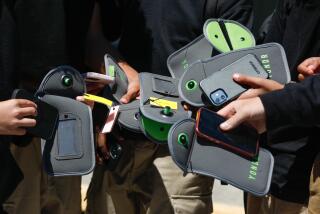Privacy Not Seen as a Hang-Up for Users of Cordless Telephones
- Share via
Cordless telephones became hot sellers in the 1980s even though it is easy for snoopy neighbors to listen in on conversations. So the Supreme Court’s refusal this week to make eavesdropping on them illegal is not expected to diminish their popularity.
“There are a lot of people who really don’t give a damn about the security (issue),” said Steve Sazegari, a research analyst with Dataquest in San Jose. “It’s more of a toy to them.”
However, Monday’s high court decision may have implications for other types of phones. It may, for example, strengthen protections against snooping on conversations over cellular and traditional wired phones. But it reduces the privacy of a caller using a wired phone and speaking with someone using a cordless one.
The decision may also create new incentives for manufacturers to produce cordless phones that are harder to monitor.
“I think the message for Americans will continue to be that if you purchase modern conveniences, such as cordless phones or baby monitors or other radio devices, it means purchasing them at the expense of your constitutional rights,” commented Randall Wilson of the Iowa Civil Liberties Union, who brought the original lawsuit on cordless phone privacy that went before the Supreme Court.
Despite their lack of privacy, enough cordless phones have been sold since sales took off about five years ago that one of every four households is equipped with a model. An estimated 9.6 million sets were sold last year, and about 11 million are expected to be bought this year, according to the Electronic Industries Assn.
Radio scanners, readily available in electronics shops, make eavesdropping on cordless phone broadcasts a snap--at least from short range, analyst Sazegari added. In contrast to illegal wiretaps of traditional phones, he said, “there’s nothing illegal” about using the equipment to monitor cordless conversations, as the high court indicated in its ruling.
Radio Shack and other retailers carry scanners for sale for about $100 and up. But a spokesman for Radio Shack’s owner, Ft. Worth-based Tandy Corp., emphasized that the equipment is intended for monitoring emergency broadcasts, such as police and fire calls, and not for snooping on neighbors.
The portable phones, which can beam conversations from across a home or outdoors to a primary wired phone inside, allow users to roam while talking. But because the broadcast takes place over a narrow band of radio frequencies set aside for the purpose by the Federal Communications Commission, nearby users may overhear--inadvertently or on purpose--a neighbor’s conversation.
This inherent lack of privacy was cited by a federal judge in throwing out a privacy-violation lawsuit in a decision upheld in appellate court last August. That was the decision that the Supreme Court let stand Monday.
U.S. District Judge Harold D. Vietor in Davenport, Iowa, had dismissed the original lawsuit, noting that the technology of cordless phones makes conversations on them more susceptible to interception.
The original lawsuit filed revolved around the case of Scott Tyler of Dixon, Iowa. Neighbors using a cordless phone stumbled upon the Tyler family’s cordless-phone conversations and concluded that they were hearing illegal drug dealing taking place. The neighbors reported that to the county sheriff, who provided equipment for them to record future conversations. As it happened, no drugs were dealt, but Tyler was convicted in late 1984 of bilking two food companies out of $35,000, even though the court refused to allow the taped conversations as evidence. Tyler and his family later sued the neighbors and county officials for invading his privacy.
“Because there was no justifiable expectation of privacy,” Judge Vietor ruled in tossing out that case, “the interceptions did not violate the Fourth Amendment.” That amendment generally bars searches and seizures without warrants.
In contrast, police have been barred since a landmark high court ruling in 1967 from secretly listening to conversations over traditional wired phones without first obtaining warrants. Congress extended that protection in 1986 to cellular car phones as well.
Cellular technology differs from cordless broadcasting because scores of low-powered receiver-transmitters are used to pick up conversations as users drive from “cell” to “cell.”
That makes monitoring of cellular phones possible, but only with very sophisticated scanning equipment, and even then it is not easy, said Betty Bienstadt, a spokeswoman for PacTel Cellular, the cellular phone division of San Francisco-based Pacific Telesis. Moreover, the sale of that sort of scanner is illegal in California, she added.
Critics of the court decision are worried about its wide-ranging implications.
“I’m sure the justices had some very good reasons for refusing to hear the case, but for now it means that every American will have to live in fear that some of his or her phone calls will not be private,” said Wilson of the Iowa Civil Liberties Union.
However, the judicial exception for cordless phones may nonetheless have “breathed new life” into the privacy protection of conversations over wired telephones, said Mark Cooper, research director of the Consumer Federation of America. If so, this might provide a new argument against letting local telephone companies sell a new service that reveals a caller’s number to the other party before the phone is answered, a feature the federation opposes.
“It’s getting to the point where the sanctity of that wire can be violated,” Cooper maintained, “and that’s what ‘caller identification’ does.”
For equipment makers, however, the decision “creates a marketing opportunity” for anyone who can make cordless phones more secure, said Susan Ryba of the North American Telecommunications Assn.
According to Mark Rosenker of the Electronics Industries Assn. in Washington, the industry is asking the FCC to require that future cordless phones have 256 different codes built in, similar to those required on garage-door opening devices, to make overhearing another’s conversation more difficult.






